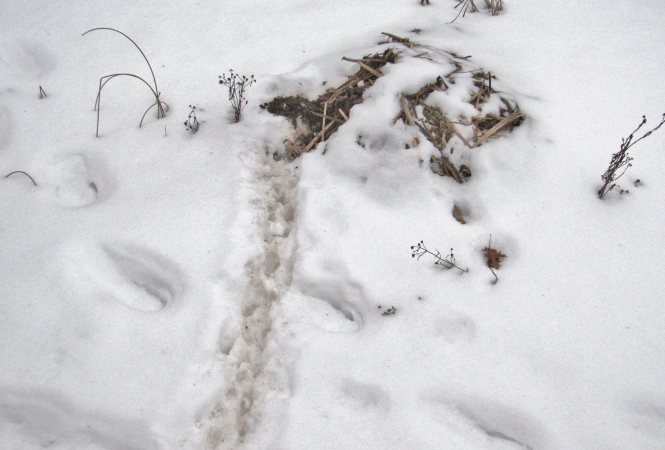WILDER SIDE OF OAKLAND COUNTY 
With a bit of imagination, the common muskrat might be compared to a very large field mouse: one with a can do attitude that easily adapts to life in the wetlands and waterways of Oakland County. To muskrats, winter is not an obstacle for cozy living. For just like beavers, the muskrat prepares, with a few additional twists of its own, to guarantee Homeland Security during winter. This paunchy appearing rodent is covered with a rich, dark brown waterproof layer of fur (except on its scaly-skin tail). As soon as ice coats the lakes of the Oakland County Parks, the well dressed for the weather muskrats create pushups. Pushups provide a unique way for them to feed, travel and stay out of sight.
Muskrats begin building pushups by chewing holes through the fresh ice. After an opening is created, lake vegetation and mud are gathered and used to make a rather pointed and tent-like structure that can be several feet high. These pushups may look like miniature muskrat lodges, but they are not homes. They are simply sheltered feeding stations and rest stops, used for underwater forays as they forage for submerged vegetation under the ice. In human terms, the pushups serve as reserved picnic shelters. Unlike the pushups, their lodges are almost always circular and dome-like. They are dry, cozy places that are lined with grasses and provide room to sleep and eat. 
The muskrat and its much bigger, flat-tailed cousin, the beaver, are the only Michigan mammals that actually build homes in the water. In addition, the muskrat shares some of the same adaptions of the beaver. A muskrat’s front teeth are modified for underwater chewing and protrude in front of its cheeks and lips. This adaptation of evolution lets muskrats chew on cattails (a favorite food) and roots under water, while keeping their mouths closed. On occasion, a bold a muskrat will emerge onto the surface of the ice. That happens to be a very dangerous proposition, as their dark fur stands out in sharp contrast to the white ice and snow. It creates a tempting target for keen-eyed red-tailed hawks soaring overhead, or a mink or coyote on marsh patrol.
The muskrat is a creature of opportunity which aids in its survival. For example, if a sluggish frog or fish is found on its underwater forays, it will be eaten. However, most of their food is found at home and is, literally, home. Muskrat lodges are comprised of all sorts of vegetation with cattail being a primary ingredient. That means the house is also a food source. To the casual human observer, these dead-looking heaps of decaying plant matter seem to be nothing of interest; that bodes well for non-detection. Muskrat lodges are simple structures with one or two plunge holes that give access to the cold, aquatic world of winter in the wetlands. Muskrats spend most of the winter in their lodges sleeping and feeding. Yet, as soon as the ice begins to melt, it’s time for spring courtship.
Text and photos by Jonathan Schechter, Nature Education Writer for Oakland County Parks. schechterj@oakgov.com
Visit Oakland County Parks for details on all 13 Oakland County Parks.

[…] moved by the pond. Maybe a Muskrat slipped back into the water or migrating Wood Ducks came in for a splash-down […]
[…] cattails rattle in the wind along lakeshores and almost hide swimming muskrats that search for aquatic greens in a nearly ice-free world. Red squirrels and chipmunks continue to […]
[…] the wilder side of Oakland County some geese discover five-star living and build a nest on top of a muskrat lodge. It’s a great lookout point to detect approaching predators, and the surrounding water […]
[…] with partially submerged logs, low-hanging branches, a beaver dam, Great Blue Herons, Great Egrets, muskrats, deer and sunning turtles. A trail best explored armed with a spirit of adventure and a paddle. […]
[…] owl, red-tailed hawk, Cooper’s hawk, turkey, turkey vulture, tree swallow, eastern bluebird, muskrat, beaver, white-tailed deer, osprey and every once in a while, an American bald eagle soars […]
[…] painted turtles trying to catch some of the sun’s warmth under the cloudy sky, and a swimming muskrat. A few seconds after the muskrat encounter, a beaver-gnawed branch drifted by. The shoreline trees […]